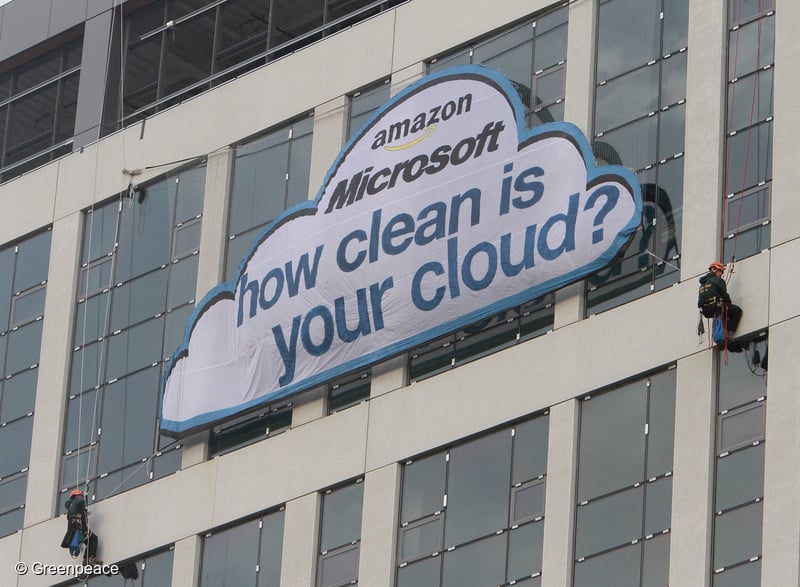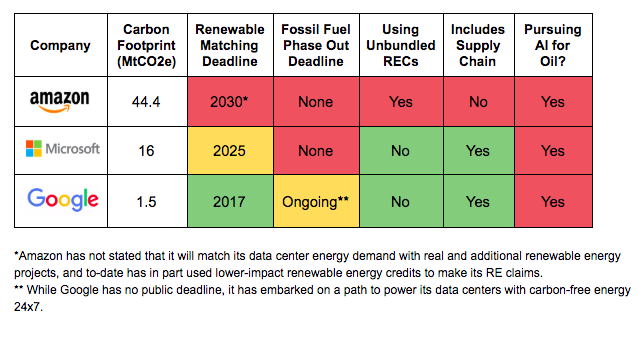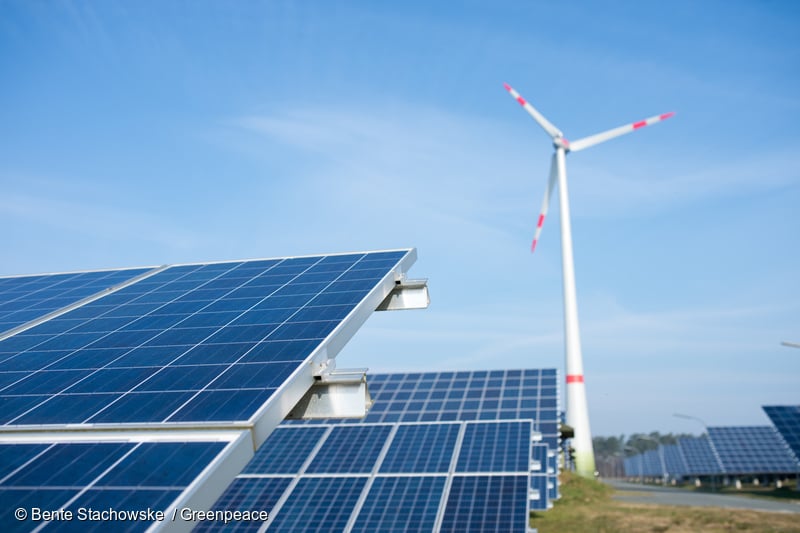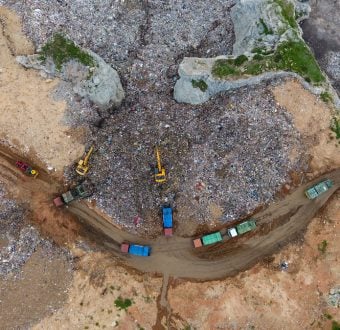Some of the world’s biggest tech companies want you to know they take climate change seriously. In fact, Amazon, Microsoft, and Google have each developed a plan to address its contributions to climate change. While each company’s plan is unique, none address their problematic contracts that help oil majors use artificial intelligence to extract more oil and gas.
Here we unpack Amazon, Microsoft, and Google’s sustainability plans. While each company earns hypocrisy points, Amazon is trailing the pack on climate action. And to make matters worse–rather than rise to the challenge, Amazon is currently threatening employees who speak out on its climate plan.
Amazon: A Pledge Without A Plan
What’s in it?
In September 2019, Jeff Bezos unveiled a new corporate “Climate Pledge” and signed up Amazon as the first participant. With this pledge, Amazon finally set a deadline to reach 100% renewable energy — 2030 — and net zero carbon by 2040. The company also said it will invest in electric delivery vehicles and carbon offset projects, but without more detailed transparency about Amazon’s climate impacts, it’s hard to judge how significant these investments are.
What’s missing? Details and Plans to Cover Whole Carbon Footprint
Amazon did not elaborate on how it would procure the renewables to meet its 2030 deadline. To date, we know the company has used a mix of solar and wind projects and renewable energy credits (RECs), which isn’t the best way to actually phase out fossil fuels from the electricity grid. The company also failed to elaborate on how it will drive its whopping 44.4 million tons CO2e carbon footprint down to zero in the next two decades. Reporting this figure was a first for Amazon, but the company remains the least transparent among the big three cloud companies, failing to provide even basic information about its energy demand. Without more details on Amazon’s energy demand by region, it’s impossible to judge the impact of Amazon’s renewable energy projects. In some places, like Virginia, Amazon’s rapid data center growth has far outpaced its renewable investment, and is therefore taking the state in the wrong direction. Data center energy demand is in fact being used by Dominion Power to justify building the Atlantic Coast Pipeline, a $7.5 billion dollar fracked gas pipeline that ratepayers will be forced to pay for.
Amazon’s renewable commitment also only covers its own operations and electricity use, but leaves out its supply chain — which, in Amazon’s case, is more than 75% of its overall carbon footprint. Amazon Web Services is the largest cloud service provider in the world, with an ever growing network of data centers, often situated in locations with dirty forms of energy. What’s more, with a delivery network as vast as Amazon’s, the company should set more aggressive goals to transition to a fully electric fleet and other lower carbon options. Plus, Amazon is offering machine learning and other AI technologies to oil companies like BP, Shell and others. That’s essentially two steps back for every step forward, Amazon.
1/ Hundreds of us decided to stand up to our employer, Amazon. We are scared. But we decided we couldn’t live with ourselves if we let a policy silence us in the face of an issue of such moral gravity like the climate crisis. #AMZNSpeakOut pic.twitter.com/zWIKku4LF6
— Amazon Employees For Climate Justice (@AMZNforClimate) January 27, 2020
It gets worse – Amazon has threatened to fire employees for speaking out about the company’s climate policy. Just yesterday, 357 workers released statements in solidarity, condemning this bullying and calling for strong renewable energy commitments. Show your solidarity — send a message to Amazon CEO Jeff Bezos to let him know you support these brave employees.
Microsoft: The “Moonshot” that Misses the Mark
What’s in it?
In January 2020, Microsoft increased its renewable energy ambition from 70% by 2023 to 100% by 2025. Notably, the company explicitly stated it would achieve this with power purchase agreements which will help to drive new investment in real renewable energy. (Previously the company’s renewable claims were met by more than 75% RECs). Microsoft also said that by 2030, it would neutralize all of its carbon emissions, including supply chain emissions, and then keep going with a long term goal to offset all historical emissions (that the company has emitted either directly or by electrical consumption) by 2050. In addition to the proceeds from its internal carbon tax, Microsoft says it will invest $1 billion in climate innovation.
What’s missing? Internal Reckoning on the Causes of Climate Change
While there is a lot to celebrate in @Microsoft’s announcement, a gaping hole remains: Microsoft is helping Big Oil extract more oil and gas with its artificial intelligence technologies.
— Greenpeace USA (@greenpeaceusa) January 16, 2020
Microsoft clearly understands carbon math and the need to account not only for ongoing emissions, but historic emissions as well. What Microsoft seems to be ignoring is the leading cause of climate change: fossil fuels. Microsoft’s contracts to help fossil fuel companies drill for more oil and gas — as much as 50,000 barrels more a day, as Microsoft offered to Exxon in Texas’ Permian Basin — do not sync at all with Microsoft’s math. These projects only fuel the climate crisis. And we have to ask, is worse coming? In 2019, Microsoft launched an AI Center for Excellence to assist the oil industry’s digital transformation and sponsored an oil and gas conference the exact same week that it announced its new climate commitment!
If Microsoft truly wishes to be carbon “negative,” it can’t simply purchase carbon offsets for these projects, but instead, must cancel these contracts altogether.
For its data centers, Microsoft should pursue local, renewable energy sources 24×7, so that it and all customers in its Azure network can gradually phase out fossil fuel use altogether, rather than the matching approach most companies have used to date.
Google’s Sustainability Commitments
What’s in it?
In 2012, Google set a long term goal to purchase enough renewable energy to match its electricity consumption globally each year, which it accomplished in 2017. Google’s approach has included some of the largest renewable energy deals to-date, totalling 3.75GW. Unlike Amazon, Google is not relying heavily on RECs. Google’s approach has been effective in shrinking its carbon footprint from an estimated 4.9 million tons CO2e (business as usual) to 1.2 million tons CO2e instead. Google is one of the most transparent companies in reporting its energy demand and energy mix by location.
What’s Missing? Complete Divorce with Fossil Fuel Industry.

Chevron’s refinery in Richmond, California. Google’s contracts with Chevron are unacceptable if we want a climate safe future.
Google has a long term ambition for its supply chain to be 100% renewable, but lacks a specific deadline. The company says it will invest $150 million in new renewable capacity in manufacturing regions, many of which still rely a great deal on coal. Unlike Microsoft, Google is not accounting for historic emissions. Since 2018, Google made a long-term commitment to power its data centers 24×7 with carbon-free energy, which helps to further phase out fossil fuels from its operations. This is why Google’s contracts with oil and gas companies like Total, Shell, Schlumberger, Chevron, and others make no sense. To be the true climate leader Google wants to be, it must cancel its AI contracts with oil and gas firms.
Big Tech Climate Plans: Still Loading…
Greater climate ambition from three of the world’s biggest tech companies is needed and welcome, but we could do with a lot less hypocrisy. Here are the four things we’re waiting to see:
1. Renewables First, then Always:
Companies looking to fix their climate problem for the long term must pursue renewable energy first, not simply offset projects. As Google’s approach has demonstrated, scaling up renewable energy use is a direct and effective way to shrink carbon footprints and as a result, reduce the need to rely on offsetting emissions in order to be “carbon neutral”. Switching to renewables is also better for the planet, as it avoids carbon emissions in the first place. Data center companies must invest in renewable energy projects in the grids in which they are located, in order to displace fossil fuels on the grid, rather than prolong demand for dirty energy. Finally, true climate leaders must find innovative ways to phase out fossil fuels from their operations altogether, even when the sun is not shining and the wind is not blowing, which is possible with energy storage.
2. Truth in Labeling:
100% Renewable, Zero Emissions, Carbon Neutral or Negative — with all these claims, it is still critical for the public to read the fine print. Companies that pursue these ambitions must be transparent about their approach and regularly report progress. Without publishing clear energy demand data broken down by location, as well as the types of energy being used in these locations, it’s impossible to assess impact. Also, so long as data center companies are still operating on fossil fuels, they should not claim to be 100% renewable. Ringing this bell prematurely only undercuts their long-term ambitions.
3. Strong Climate Advocacy:
Microsoft, Amazon and Google all have global operations — with dozens if not hundreds of data centers as well as a long chain of manufacturing suppliers. While all 3 companies have committed to use 100% renewable energy, this is made difficult in practice in some places, because of regulations that restrict renewable energy development in place of dirty, legacy energy options. A prime example of this is Virginia–the global epicenter of the internet, because of its high concentration of data centers — where the energy utility holds a monopoly and gives very limited renewable options. In such regions, tech companies must advocate for smart policies that allow for rapid scaling up of local, renewable energy supply.
4. Break up with Big Oil:
Undercutting all three of these companies’ climate plans is their ongoing partnerships with oil and gas firms. Big Tech has been wooing Big Oil with the promise that machine learning and other AI capabilities will help them find and extract oil and gas more effectively. If we are to stave off further catastrophic warming, this is the decade that counts — it is not the time to bolster the industry that caused this problem in the first place.
Microsoft, Google and Amazon have to make a choice — which side are you on? The side of people and planet, or the oil and gas industry? If these companies continue to prop up the fossil fuel industry, all their climate plans, no matter how shiny and ambitious, will be duplicitous.






